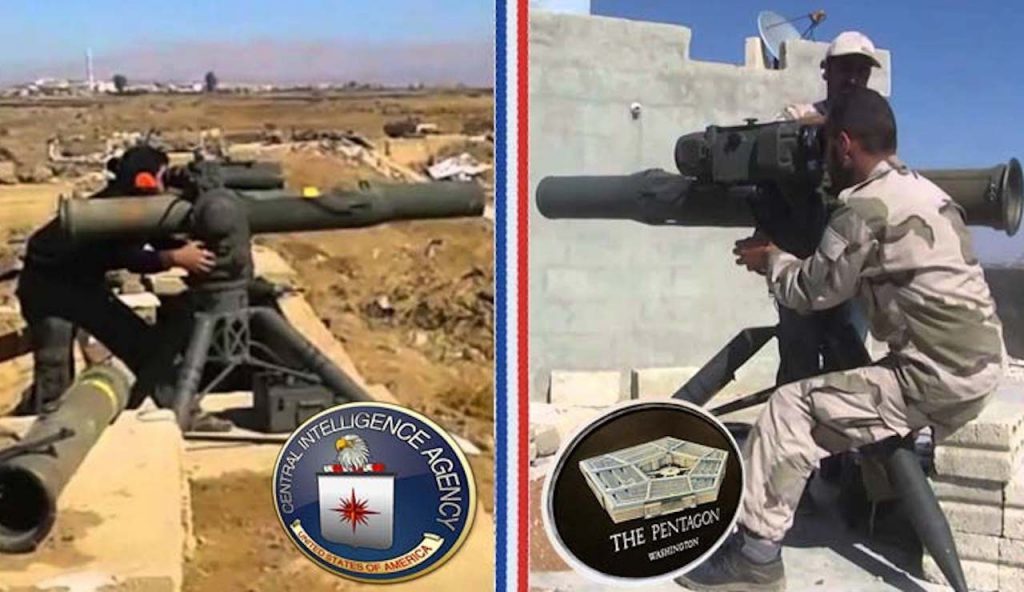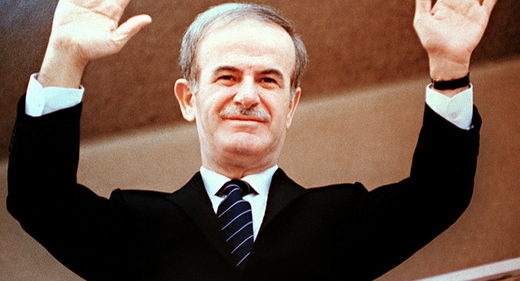Documents contained in the U.S. National Archives and drawn up by the CIA reveal a plan to destroy the Syrian government going back decades. One such document entitled, "Bringing Real Muscle To Bear In Syria," written by CIA officer Graham Fuller, is particularly illuminating. In this document, Fuller wrote,
Even as far back as 1983, Syrian President Bashar al-Assad's father, Hafez Assad, was viewed as a gadfly to the plans of Western imperialists seeking to weaken both the Iraqis and the Iranians and extend hegemony over the Middle East and Persia. The document shows that Assad and hence Syria represented a resistance to Western imperialism, a threat to Israel, and that Assad himself was well aware of the game the United States, Israel, and other members of the Western imperialist coalition were trying to play against him.Syria at present has a hammerlock on US interests both in Lebanon and in the Gulf - through closure of Iraq's pipeline thereby threatening Iraqi internationalization of the [Iran-Iraq] war. The US should consider sharply escalating the pressures against Assad [Sr.] through covertly orchestrating simultaneous military threats against Syria from three border states hostile to Syria: Iraq, Israel and Turkey.
I encourage the reader to access my article, "1983 CIA Document Reveals Plan To Destroy Syria, Foreshadows Current Crisis," to read more about this document.
The question of the Assad thorn in the side of the West continued on for the United States as was evidenced by yet another CIA document from 1986 entitled "Syria: Scenarios of Dramatic Political Change." Although not an open advocation of destabilization and/or war, the paper does examine the possibilities of destabilization and "regime change" in Syria, most notably in the scenario of mass unrest, Muslim Brotherhood manipulation and violence, defections, and a coup.
After giving a summation of "The Present Scene" and "Major Players" that include Hafez Assad's inner circle, the military, Sunnis, and Muslim Brotherhood, the paper goes into a description of possible ways Assad's government could be brought down and replaced with one more friendly to Western interests. The ways in which this takedown could be accomplished ranged from a military coup, a military defeat, and/or mass public unrest and destabilization. It should also be noted that the report attempts to paint Sunnis and the Muslim Brotherhood as one in the same. However, the MB does not and never has represented the majority of Sunnis in Syria. Thus, when the CIA document mentions "Sunnis" it is referring to the extremist Muslim Brotherhood factions of society.
In a subsection entitled, "Communal Violence Escalates Into Civil War," the document reads,
Thus, while observing potential flareups for social violence, one major aspect of the destabilization of 2011, the CIA viewed the Sunni population, more specifically the Muslim Brotherhood, as the one that would be the most volatile element of society and also that it might be funded from the outside. The CIA predicted "defections" and a "civil war" drawn along religious lines. This "potential" situation was attempted by the CIA in 2011 but was forced to rely on outside Sunni fighters since the fiercely secular Syrian people were not able to be coaxed into a religious civil war as easily as the CIA imagined.Sunni dissidence has been minimal since Assad crushed the Muslim Brotherhood in the early 1980s, but deep-seated tensions remain - keeping alive the potential for minor incidents to grow into major flareups of communal violence. For example, disgruntlement over price hikes, altercations between Sunni citizens and police forces, or anger at privileges accorded to Alawis at the expense of Sunnis could foster small-scale protests. Excessive government force in quelling such disturbances might be seen by Sunnis as evidence of a government vendetta against all Sunnis, precipitating even larger protests by other Sunni groups.
Sunni merchants and artisans probably would launch protests similar to those staged in previous years, for example by closing down businesses and the bazaars in Hamah or Aleppo and possibly Damascus. Sunni students would stage campus demonstrations, and Sunni professional associations would organize stoppages. Mistaking the new protests as a resurgence of the Muslim Brotherhood, the government would step up its use of force and launch violent attacks on a broad spectrum of Sunni community leaders as well as on those engaged in the protests. Regime efforts to restore order would founder if government violence against protesters inspired broad-based communal violence between Alawis and Sunnis.
A general campaign of Alawi violence against Sunnis might push even moderate Sunnis to join the opposition. Remnants of the Muslim Brotherhood - some returning from exile in Iraq - could provide a core of leadership for the movement. Although the regime has the resources to crush such a venture, we believe brutal attacks on Sunni civilians might prompt large numbers of Sunni officers and conscripts to desert or to stage mutinies in support of dissidents, and Iraq might supply them with sufficient weapons to launch a civil war.
Indicators Of A Developing Scenario· Strikes and demonstrations demanding government action to end discrimination against Sunnis become frequent.
· Security personnel force businesses to reopen and confiscate the inventories of many.
· The government conducts the indiscriminate roundups of Sunni leaders.
· Syrian leaders accuse Iraq and the Muslim Brotherhood of fomenting unrest.
· Violent indicators including bombings of Sunni social gatherings take place; Sunnis retaliate with similar violence against Alawis.
· Government attacks on suspected Sunnis dissidents increase; sometimes razing whole blocks in Sunni residential areas
· Sunni troops refuse to fire on demonstrators; some units mutiny and join growing Sunni opposition movements.
The CIA document also addressed the "Soviet Angle," opining about ways in which the strong ties between the Russia/Soviet Union and Syria could be broken and the situations which might bring that separation about. The document comes to the conclusion that a military defeat, most likely against Israel, would prove Soviet weapons and military training inferior, forcing Syria to rely more heavily on the West for training and equipment and thus become more pliable to the Western agenda.
In the section entitled, "Implications For The United States," the document states that the most ideal situation for the US would be to see the Assad government overthrown and replaced by a "Sunni regime controlled by business-oriented moderates." This essentially refers to a Muslim Brotherhood coup against the Syrian government which would of course follow with a regime that is much more favorable and cooperative with the Western agenda than that of Assad's Syria. The document also hints at the desire to see the new "Sunni business-oriented moderate" government's interest in the "private sector," which historically has come to mean major Western corporations that take over public services and natural resources and turn them into commodities.
While this document did not provide a strategy by which to achieve the desired outcomes it lists (at least not in the sanitized declassified version), it still follows the same train of thought as the CIA document released three years prior in that it hopes for the collapse of deposition of the Assad government and the replacement of that government with one that is more friendly to Western aims. The US government went ahead with the implementation of this plan in 2011 that has resulted in over 400,000 deaths in Syria over the course of seven years of warfare.
Brandon Turbeville is the author of seven books, Codex Alimentarius - The End of Health Freedom, 7 Real Conspiracies, Five Sense Solutions and Dispatches From a Dissident, volume 1 and volume 2, The Road to Damascus: The Anglo-American Assault on Syria, The Difference it Makes: 36 Reasons Why Hillary Clinton Should Never Be President, and Resisting The Empire: The Plan To Destroy Syria And How The Future Of The World Depends On The Outcome. Turbeville has published over 1000 articles on a wide variety of subjects including health, economics, government corruption, and civil liberties. Brandon Turbeville's radio show Truth on The Tracks can be found every Monday night 9 pm EST at UCYTV. His website is BrandonTurbeville.com He is available for radio and TV interviews. Please contact activistpost (at) gmail.com.





Comment: The US is in the midst of trying to pull off its plan, though it's not going as well as hoped.